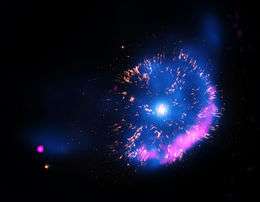Nova remnant

A nova remnant is made up of the material either left behind by a sudden explosive fusion eruption by classical novae, or from multiple ejections by recurrent novae. Over their short lifetimes, nova shells show expansion velocities of around 1000 km/s,[1] whose faint nebulosities are usually illuminated by their progenitor stars via light echos as observed with the spherical shell[1] of Nova Persei 1901[2] or the energies remaining in the expanding bubbles like T Pyxidis.[3]
Most novae require a close binary system, with a white dwarf and a main sequence, sub-giant, or red giant star, or the merging of two red dwarfs, so probably all nova remnants must be associated with binaries.[4] This theoretically means these nebula shapes might be affected by their central progenitor stars and the amount of matter ejected by novae.[1] The shapes of these nova nebulae are of much interest to modern astrophysicists.[1][4]
Nova remnants when compared to supernova remnants or planetary nebulae generate much less both in energy and mass. They can be observed for perhaps a few centuries.[1] Examples of novae displaying nebula shells or remnants include: GK Per, RR Pic, DQ Her, FH Ser, V476 Cyg, V1974 Cyg, HR Del and V1500 Cyg.[1][5] Notably, more nova remnants have been found with the new novae, due to improve imaging technology like CCD and at other wavelengths.
See also
References
- 1 2 3 4 5 6 Lloyd, H.M.; O'Brien, T.J.; Bode, M.F. (1997). "Shaping of nova remnants by binary motion". Monthly Notices of the Royal Astronomical Society. 284: 137–147. Bibcode:1997MNRAS.284..137L. doi:10.1093/mnras/284.1.137.
- ↑ Liimets, T.; Corradi, R.L.M.; Santander-García, M.; Villaver, E.; Rodríguez-Gil, P.; Verro, K.; Kolka, I. (2014). "A Dynamical Study of the Nova Remnant of GK Persei / Stella Novae: Past and Future Decades". ASP Conference Series, Proceedings of a conference held 4–8 February 2013 at the Pavilion Clock Tower, Cape Town, South Africa. Edited by P.A. Woudt and V.A.R.M. Ribeiro, 2014. 490: 109–115. arXiv:1310.4488. Bibcode:2014ASPC..490..109L. doi:10.1086/109995.
- ↑ Ogley, R. N.; Chaty, S.; Crocker, M.; Eyres, S. P. S.; et al. (Apr 2002). "A search for radio emission from Galactic supersoft X-ray sources". Monthly Notices of the Royal Astronomical Society. 330 (4): 772–7. arXiv:astro-ph/0111120. Bibcode:2002MNRAS.330..772O. doi:10.1046/j.1365-8711.2002.05130.x.
- 1 2 Bode, M.F. (2002). "The Evolution of Nova Remnants". AIP Conference Proceedings: Classical Nova Explosions: International Conference on Classical Nova Explosions. 637: 497–508. arXiv:astro-ph/0211437. Bibcode:2002AIPC..637..497B. doi:10.1063/1.1518252.
- ↑ Lloyd, H. M.; O'Brien, T. J.; Bode, M. F. (1997). "Shaping of nova remnants by binary motion". Monthly Notices of the Royal Astronomical Society. 284: 137. Bibcode:1997MNRAS.284..137L. doi:10.1093/mnras/284.1.137.
Gallery

External links
- T Pyxidis Nova Remnant (HubbleSite)
- Double-star systems cycle between big and small blasts (The Carnegie Observatories)
- Nova Remnant comparison table (UOttawa)
- Nova Remnant (UOttawa)